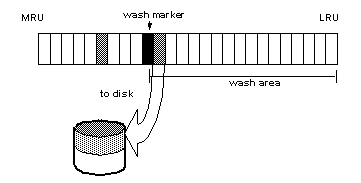If the wash area in a pool is too large in a pool, the buffers move too quickly past the “wash marker” in cache, and an asynchronous write is started on any dirty buffers, as shown in Figure 4-4. The buffer is marked “clean” and remains in the wash area of the MRU/LRU chain until it reaches the LRU. If another query changes a page in the buffer, Adaptive Server must perform additional I/O to write it to disk again.
If sp_sysmon output shows a high percentage of buffers “Found in Wash” for a strict replacement policy cache, and there are no problems with dirty buffer grabs, you may want to try reducing the size of the wash area. See the Performance and Tuning Series: Monitoring Adaptive Server with sp_sysmon for more information.
Figure 4-4: Effects of making the wash area too large
